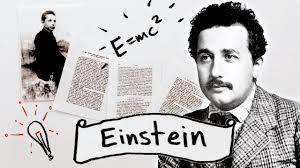In 1905, Albert Einstein published a series of papers
在1905年,阿尔伯特·爱因斯坦发表了一系列论文,
that many consider a starting point for the modern age of physics.
被公认为是物理新时代的开端。
But other than "E equals m c squared", most people only know that Einstein was famous, not for what he was famous.
但是除了“E=mc2”,大多数人都只知道爱因斯坦很著名,却并不知道他因何而著名。
Since this week marks the 133rd anniversary of his birth,
这周恰好是爱因斯坦的133个诞辰,
as is customary in western traditions we will celebrate by taking a brief tour of his scientific publications.
按照西方的惯例,我们来回顾一下他的科学成就,以此纪念这位伟人。
Today, his paper from March, 1905 on why light is a particle.
今天的内容是他在1905年3月发表的关于光为什么是粒子的论文。
Einstein didn't just pull this idea out of thin air –
爱因斯坦并非凭空想出了这么一个观点,

he first noted that the light emitted from something hot (like a lightbulb filament), actually has the same energy distribution as a gas,
他首先注意到从一个热的物体中发出的光(比如灯泡)带有类似于气体的能量,
which is somewhat surprising if you're a nineteenth century physicist
这对于19世纪的物理学家来说简直不可理喻,
who thinks that light is a continuous wave and very much not a gas composed of individual molecules.
他们觉得光是一种波,与由单一的分子构成的气体全然不同。
And while the idea that "light behaves kind of like a gas" was already well known before Einstein,
虽然“光的性状有点类似气体”的观点在爱因斯坦之前已经十分著名,
no one had taken the logical but crazy next step to conclude that
但没有人敢于得出一个合乎逻辑而疯狂的结论:
light must then be made of individual particles, too!
光也由粒子构成。
So Einstein proposed that these "light-quanta" were in fact real particles
因此爱因斯坦认为这些“光子”真实存在,
that could account for a few recent and unexplained experiments
并可以用于解释一些最近的奇怪的实验。
having to do with knocking electrons off of metals or gas molecules.
比如,光能把金属或气体分子表面的电子撞下来。
He turned out to be right on all counts and got a nobel prize for his work…
他的结论是正确的,因而得到了一个崇高的奖励。
but that's a story for another day.
至于这个故事,我们下次再讲。











